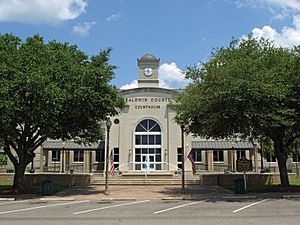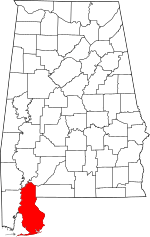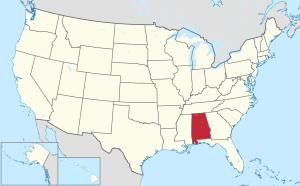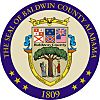Baldwin County, Alabama facts for kids
Quick facts for kids
Baldwin County
|
||
|---|---|---|

The Baldwin County Courthouse in Bay Minette
|
||
|
||

Location within the U.S. state of Alabama
|
||
 Alabama's location within the U.S. |
||
| Country | ||
| State | ||
| Founded | December 21, 1809 | |
| Named for | Abraham Baldwin | |
| Seat | Bay Minette | |
| Largest city | Daphne | |
| Area | ||
| • Total | 2,027 sq mi (5,250 km2) | |
| • Land | 1,590 sq mi (4,100 km2) | |
| • Water | 437 sq mi (1,130 km2) 21.6% | |
| Population
(2020)
|
||
| • Total | 231,767 | |
| • Estimate
(2023)
|
253,507 |
|
| • Density | 114.340/sq mi (44.147/km2) | |
| Time zone | UTC−6 (Central) | |
| • Summer (DST) | UTC−5 (CDT) | |
| Congressional district | 1st | |
|
||
Baldwin County is a county located in the southwestern part of the U.S. state of Alabama, on the Gulf coast. It is one of only two counties in Alabama that border the Gulf of Mexico, along with Mobile County. As of the 2020 census, the population was 231,767, making it the fourth-most populous county in Alabama. The county seat is Bay Minette. The county is named after the founder of the University of Georgia, Senator Abraham Baldwin.
Baldwin was Alabama's fastest-growing county from 2010 to 2020, with 4 of the top 10 fastest-growing cities in the state in recent years.
The U.S. federal government designates Baldwin County as the Daphne-Fairhope-Foley, AL metropolitan statistical area.
It is the largest county in Alabama by area and is located on the eastern side of Mobile Bay. Part of its western border with Mobile County is formed by the Spanish River, a brackish distributary river.
History
Baldwin County was established on December 21, 1809, ten years before Alabama became a state. Previously, the county had been a part of the Mississippi Territory until 1817, when the area was included in the separate Alabama Territory. Statehood was gained by Alabama in 1819.
There have been numerous border changes to the county as population grew and other counties were formed. Numerous armies have invaded during the Revolutionary War, War of 1812, and Civil War.
In the first days of Baldwin County, the town of McIntosh Bluff on the Tombigbee River was the county seat. (It is now included in Washington County, northwest of Baldwin County.) The county seat was transferred to the town of Blakeley in 1820, and then to the city of Daphne in 1868. In 1900, by an act of the legislature of Alabama, the county seat was authorized for relocation to the city of Bay Minette; however, the city of Daphne resisted this relocation.
To achieve the relocation, the men of Bay Minette devised a scheme. They fabricated a murder to lure the sheriff and his deputy out of the city of Daphne. While the law was chasing down the fictitious killer during the late hours, the group of Bay Minette men stealthily traveled the seventeen miles (27 km) to Daphne, stole the Baldwin County Courthouse records, and delivered them to the city of Bay Minette, where Baldwin County's county seat remains. A New Deal mural, completed by WPA artists during the Great Depression, depicts these events. It hangs in the Bay Minette United States Post Office.
During the American Civil War, 32 men hailing from Baldwin County enlisted with a Union unit mustered in Pensacola, Florida, called the 1st Florida Cavalry Regiment. In 1860, Baldwin County was the least populous of Alabama's 52 counties. Half of the population were enslaved. There was also a large population of Muscogee (Creek) in the northern portion of the county.
During the Cold War, the vice president of Foley-based Gulf Telephone Company, John Mcclure Snook, formed a private militia to resist a potential Communist invasion from the Gulf of Mexico. Due to this militia being armed with automatic weapons from Snook's personal collection, the federal government seized the weapons as part of an order during a 1964 libel proceeding. Although Snook paid the taxes imposed on the manufacture of automatic firearms, he sued for a refund on the basis that his militia served as auxiliary deputies for the Baldwin County Sheriff. The United States Court of Appeals for the Fifth Circuit rejected this argument in a 1971 decision as his militia never performed services where use of those weapons were deemed necessary.
Due to its proximity to the Gulf of Mexico, Baldwin County frequently endures tropical weather systems, including hurricanes. Since the late 20th century, the county has been declared a disaster area multiple times. This was due to heavy damages in September 1979 from Hurricane Frederic, July 1997 from Hurricane Danny, September 1998 from Hurricane Georges, September 2004 from Hurricane Ivan, August 2005 from Hurricane Katrina and September 2020 from Hurricane Sally.
Geography
According to the United States Census Bureau, the county has a total area of 2,027 square miles (5,250 km2), of which 1,590 square miles (4,100 km2) is land and 437 square miles (1,130 km2) (21.6%) is water. It is the largest county by area in Alabama and the 12th-largest county east of the Mississippi River. It is larger than the US state of Rhode Island.
Adjacent counties
- Monroe County - northeast
- Escambia County, Florida - east
- Escambia County, Alabama - east
- Mobile County - west
- Washington County - northwest
- Clarke County - northwest
Regions
- North Baldwin
- Eastern Shore
- Central Baldwin
- South Baldwin
- Southwest Baldwin
- East Baldwin
Environmental recognition
Two separate areas in Baldwin County have been designated as "Outstanding Alabama Water" by the Alabama Environmental Management Commission, which oversees the Alabama Department of Environmental Management. As of April 2007, only two other areas in Alabama have received what is the "highest environmental status" in the state. A portion of Wolf Bay and 42 miles (68 km) of the Tensaw River in northern Baldwin County have received the designation. Officials believe the "pristine water" will become an important eco-tourism destination.
National protected area
Transportation
Major highways
 Interstate 10
Interstate 10 Interstate 65
Interstate 65 U.S. Highway 31
U.S. Highway 31 U.S. Highway 90
U.S. Highway 90 U.S. Highway 98
U.S. Highway 98 State Route 59
State Route 59 State Route 104
State Route 104 State Route 180
State Route 180 State Route 181
State Route 181 State Route 182
State Route 182 State Route 225
State Route 225 State Route 287
State Route 287 Baldwin Beach Express
Baldwin Beach Express
Airports
- Bay Minette, 1R8, has a single runway 08/26 that is 5,497'
- Fairhope, KCQF, has a single runway 01/19 that is 6,604'
- Foley, 5R4, has a single runway 18/36 that is 3,700'
- Stockton, Hubbard Landing Seaplane Base HL2 has one water runway that is 6,000’
- Gulf Shores, Jack Edwards Airport JKA has two runways, 09/27 at 6,962' and 17/35 at 3,596'
There are numerous private airports and heliports in Baldwin County. Considerable military airspace overlies much of the county and adjacent bay and coastal waters.
Commercial, scheduled service is from Mobile Regional Airport, Mobile Downtown Airport, or Pensacola International Airport.
Demographics
| Historical population | |||
|---|---|---|---|
| Census | Pop. | %± | |
| 1810 | 1,427 | — | |
| 1820 | 1,713 | 20.0% | |
| 1830 | 2,324 | 35.7% | |
| 1840 | 2,951 | 27.0% | |
| 1850 | 4,414 | 49.6% | |
| 1860 | 7,530 | 70.6% | |
| 1870 | 6,004 | −20.3% | |
| 1880 | 8,603 | 43.3% | |
| 1890 | 8,941 | 3.9% | |
| 1900 | 13,194 | 47.6% | |
| 1910 | 18,178 | 37.8% | |
| 1920 | 20,730 | 14.0% | |
| 1930 | 28,289 | 36.5% | |
| 1940 | 32,324 | 14.3% | |
| 1950 | 40,997 | 26.8% | |
| 1960 | 49,088 | 19.7% | |
| 1970 | 59,382 | 21.0% | |
| 1980 | 78,556 | 32.3% | |
| 1990 | 98,280 | 25.1% | |
| 2000 | 140,415 | 42.9% | |
| 2010 | 182,265 | 29.8% | |
| 2020 | 231,767 | 27.2% | |
| 2023 (est.) | 253,507 | 39.1% | |
| U.S. Decennial Census 1790–1960 1900–1990 1990–2000 2010–2020 |
|||
2020 census
| Race / Ethnicity (NH = Non-Hispanic) | Pop 2000 | Pop 2010 | Pop 2020 | % 2000 | % 2010 | % 2020 |
|---|---|---|---|---|---|---|
| White alone (NH) | 120,868 | 152,200 | 186,495 | 86.08% | 83.50% | 80.47% |
| Black or African American alone (NH) | 14,357 | 16,966 | 18,001 | 10.22% | 9.31% | 7.77% |
| Native American or Alaska Native alone (NH) | 753 | 1,146 | 1,291 | 0.54% | 0.63% | 0.56% |
| Asian alone (NH) | 531 | 1,340 | 2,029 | 0.38% | 0.74% | 0.88% |
| Pacific Islander alone (NH) | 37 | 79 | 122 | 0.03% | 0.04% | 0.05% |
| Other race alone (NH) | 104 | 245 | 775 | 0.07% | 0.13% | 0.33% |
| Mixed race or Multiracial (NH) | 1,299 | 2,297 | 10,368 | 0.93% | 1.26% | 4.47% |
| Hispanic or Latino (any race) | 2,466 | 7,992 | 12,686 | 1.76% | 4.38% | 5.47% |
| Total | 140,415 | 182,265 | 231,767 | 100.00% | 100.00% | 100.00% |
As of the 2020 census, there were 231,767 people, 93,116 households, and 64,222 families residing in the county. The population density was 145.8 inhabitants per square mile (56.3/km2) There were 124,148 housing units.
2010 census
As of the census of 2010, there were 182,265 people, 73,180 households, and 51,151 families residing in the county. The population density was 110 people per square mile (42 people/km2). There were 104,061 housing units at an average density of 54 units per square mile (21 units/km2). The racial makeup of the county was 85.7% White, 9.4% Black or African American, 0.7% Native American, 0.7% Asian, 0.04% Pacific Islander, 2.0% from other races, and 1.5% from two or more races. 4.4% of the population were Hispanic or Latino of any race.
There were 73,180 households, out of which 28.0% had children under the age of 18 living with them, 54.5% were married couples living together, 11.1% had a female householder with no husband present, and 30.1% were non-families. 25.1% of all households were made up of individuals, and 10.2% had someone living alone who was 65 years of age or older. The average household size was 2.46 and the average family size was 2.93.
In the county, the population was spread out, with 23% under the age of 18, 10.6% from 18 to 24, 24.4% from 25 to 44, 28.3% from 45 to 64, and 16.9% who were 65 years of age or older. The median age was 41.1 years. For every 100 females, there were 95.7 males. For every 100 females age 18 and over, there were 95.46 males.
The median income for a household in the county was $40,250, and the median income for a family was $47,028. Males had a median income of $34,507 versus $23,069 for females. The per capita income for the county was $20,826. 10.10% of the population and 7.60% of families were below the poverty line. 13.10% of those under the age of 18 and 8.90% of those 65 and older were living below the poverty line.
Education
Baldwin County contains three public school districts. There are approximately 32,500 students in public K-12 schools in Baldwin County. Prior to the 2019–2020 school year, there was only one school district, overseen by the Baldwin County Board of Education. The city of Gulf Shores has since set up its own school system, following a city council vote in 2017. In the spring of 2022, the city council of Orange Beach also voted to breakaway from the county school system.
There are Catholic elementary schools in the county, including Christ the King (Daphne), St. Patrick (Robertsdale) and St. Benedict (Elberta). Beginning in 2016, there is also a Catholic high school, St. Michael Catholic High School, located just east of Fairhope.
Coastal Alabama Community College has several campuses in the county. The United States Sports Academy is a private university focused on sports and located in Daphne.
Districts
School districts include:
- Baldwin County School District
- Gulf Shores City School District
- Orange Beach City School District
Communities
Cities
- Bay Minette (county seat)
- Daphne
- Fairhope
- Foley
- Gulf Shores
- Loxley
- Orange Beach
- Robertsdale (includes Rosinton)
- Spanish Fort
Towns
Census-designated place
Unincorporated areas
- Barnwell
- Battles Wharf
- Belforest
- Blacksher
- Bromley
- Carpenter's Station
- Clay City
- Crossroads
- Elsanor
- Fort Morgan
- Gasque
- Gateswood
- Hurricane
- Josephine
- Latham
- Little River
- Malbis
- Marlow
- Miflin
- Montrose
- Oak
- Ono Island
- Oyster Bay
- Pine Grove
- Rabun
- Seacliff
- Seminole
- Tensaw
Ghost town
- Belle Fontaine
- Blakeley
County subdivisions
The United States Census Bureau divides counties into county subdivisions. In Baldwin County, these are currently in to form of census county divisions. The county's historical subdivisions and their populations in the decennial censuses are as follows:
1870
| Subdivision | 1870 |
|---|---|
| Township 1 south | 160 |
| Township 2 south | 278 |
| Township 3 south | 480 |
| Township 4 south | 480 |
| Township 5 south | 640 |
| Township 6 south | 1,120 |
| Township 7 south | 640 |
| Township 8 south | 320 |
| Township 9 south | 320 |
| Township 1 north | 320 |
| Township 2 north | 480 |
| Township 3 north | 320 |
| Township 4 north | 446 |
| County total | 6,004 |
1880
| Subdivision | 1880 |
|---|---|
| Beat 1 | 1,489 |
| Beat 2 | 5,976 |
| Beat 3 | 1,138 |
| County total | 8,603 |
1890–1900
| Subdivision | 1890 |
1900 |
|---|---|---|
| Precinct 1, Montgomery Hill | 2,035 | 2,268 |
| Precinct 2, Stockton | 943 | 1,387 |
| Precinct 3, Perdido Station | 470 | 1,075 |
| Precinct 4, Bay Minette | 1,022 | 1,593 |
| Precinct 5, Halmons [sic] | 492 | 632 |
| Precinct 6, Sibleys Mill | 294 | 939 |
| Precinct 7, Courthouse (including Daphne) |
641 | 1,099 |
| Precinct 8, Battles Wharf | 1,314 | 1,837 |
| Precinct 9, Lowell | 506 | 696 |
| Precinct 10, Helton | 346 | 490 |
| Precinct 11, Shell Banks | 310 | 769 |
| Precinct 12, Camp Powell | 568 | 409 |
| County total | 8,941 | 13,194 |
1910–1950
| Subdivision | 1910 |
1920 |
1930 |
1940 |
1950 |
|---|---|---|---|---|---|
| Precinct 1, Blackshear [sic] | 1,293 | 1,076 | 945 | 1,042 | 643 |
| Precinct 2, Montgomery Hill and Latham | 764 | 864 | 704 | 692 | 638 |
| Precinct 3, Stockton and Deans | 1,432 | 1,880 | 1,870 | 1,782 | 2,140 |
| Precinct 4, Bay Minette | 2,336 | 2,693 | 4,271 | 4,723 | 6,264 |
| Precinct 5, Perdido and Lottie | 1,012 | 1,710 | 1,834 | 2,024 | 1,832 |
| Precinct 6, Stapleton and Ducks (1910–1920) Precinct 6, Stapleton (1930–1950) |
900 | 1,021 | 1,045 | 1,330 | 1,437 |
| Precinct 7, Holmans and Gateswood | 757 | 1,011 | 519 | 585 | 489 |
| Precinct 8, Daphne | 1,507 | 1,608 | 2,131 | 2,723 | 3,814 |
| Precinct 9, Loxley and Robertsdale (including Silverhill) |
1,785 | 2,301 | 4,380 | 4,981 | 6,655 |
| Precinct 10, Fairhope and Zundels | 2,025 | 1,963 | 3,681 | 3,917 | 6,505 |
| Precinct 11, Summerdale and Marlow | 856 | 993 | 1,766 | 1,808 | 1,879 |
| Precinct 12, Seminole and Lillian | 437 | 356 | 605 | 1,049 | 964 |
| Precinct 13, Elberta and Josephine | 715 | 1,025 | 1,272 | 1,239 | 1,384 |
| Precinct 14, Foley and Magnolia Springs | 1,019 | 1,214 | 2,370 | 3,081 | 4,715 |
| Precinct 15, Bon Secour and Palmetto Beach (1910–1940) Precinct 15, Bon Secour and Canal (1950) |
1,340 | 1,015 | 896 | 1,348 | 1,638 |
| County total | 18,178 | 20,730 | 28,289 | 32,324 | 40,997 |
1960–present
| Subdivision | 1960 |
1970 |
1980 |
1990 |
2000 |
2010 |
2020 |
|---|---|---|---|---|---|---|---|
| Bay Minette CCD | 10,788 | 13,347 | 17,040 | 18,058 | 21,877 | 23,604 | 25,186 |
| Daphne CCD (including Spanish Fort) |
5,402 | 8,461 | 13,563 | 19,135 | 28,904 | 41,295 | 55,767 |
| Elberta CCD (including Perdido Beach) |
2,385 | 3,076 | 4,230 | 6,341 | 10,473 | 10,957 | 13,668 |
| Fairhope CCD | 8,745 | 10,562 | 13,782 | 16,331 | 20,780 | 25,894 | 33,920 |
| Foley CCD (including Gulf Shores, Magnolia Springs, and most of Orange Beach) |
7,788 | 10,416 | 14,133 | 20,687 | 31,271 | 48,089 | 64,862 |
| Perdido CCD | 1,675 | — | — | — | — | — | — |
| Robertsdale CCD (including Loxley and Silverhill) |
7,847 | 8,257 | 9,993 | 11,849 | 18,854 | 24,317 | 29,160 |
| Stockton CCD | 2,899 | 3,470 | 3,704 | 3,565 | 4,161 | 3,804 | 3,745 |
| Summerdale CCD | 1,559 | 1,793 | 2,111 | 2,314 | 4,095 | 4,305 | 5,459 |
| County total | 49,088 | 59,382 | 78,556 | 98,280 | 140,415 | 182,265 | 231,767 |
See also
 In Spanish: Condado de Baldwin (Alabama) para niños
In Spanish: Condado de Baldwin (Alabama) para niños





